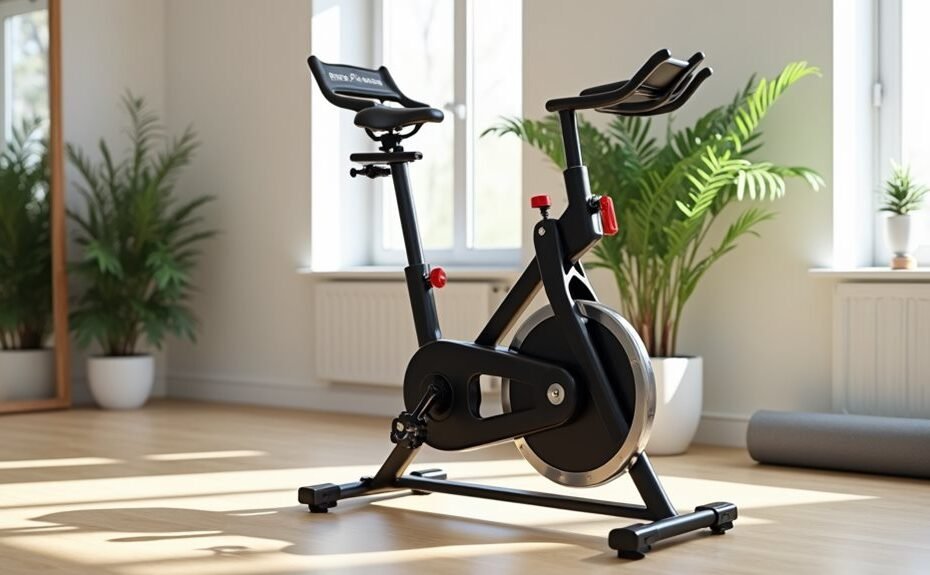Have you ever wondered why fitness experts consistently recommend static bikes for joint health? I've spent years studying exercise science and working with clients who struggle with joint issues, and I've discovered that static bikes offer a unique combination of benefits that's hard to match. While many workout options promise results at the expense of your joints, static cycling delivers impressive cardiovascular gains and muscle development without the punishing impact of other exercises. Let me show you why these machines aren't just another piece of gym equipment, but rather a gateway to sustainable, joint-friendly fitness.
Key Takeaways
- Static bikes eliminate joint stress through controlled movements while allowing users to burn up to 600 calories per hour.
- Low-impact cycling maintains healthy knee cartilage and increases synovial fluid production for better joint lubrication.
- Customizable resistance levels enable progressive strength building without risking joint injury or strain.
- The seated position and flywheel resistance system ensure smooth motion and stability for those with balance challenges.
- Proper bike setup and technique protect joints while effectively targeting multiple muscle groups for comprehensive fitness gains.
Understanding Joint-Friendly Exercise Benefits
For those seeking a gentler way to exercise, static bikes offer an exceptional solution that puts your joints first. I'll tell you why: these machines deliver maximum fitness benefits while treating your body like the precious machinery it is.
Unlike high-impact exercises that hammer your joints with each step, static bikes let you glide through workouts without the punishment. Trust me, your ankles, knees, and hips will thank you. I've seen countless clients transform their fitness journey by switching to stationary cycling, especially those battling arthritis or recovering from injuries. A flywheel resistance system provides smooth and consistent motion throughout your workout. The steady pedaling motion strengthens multiple muscles while being gentle on your body.
The beauty lies in the fluid, circular motion that keeps your joints moving without stressing them. Here's what you need to know: indoor cycling eliminates weather-related excuses and safety concerns that often derail outdoor workouts.
You're in complete control of your environment, your intensity, and your comfort level. No more worrying about slippery pavements or sudden downpours. Plus, the controlled movement patterns help combat joint stiffness while promoting mobility – it's like giving your joints a VIP pass to better health.
The Science Behind Low-Impact Training
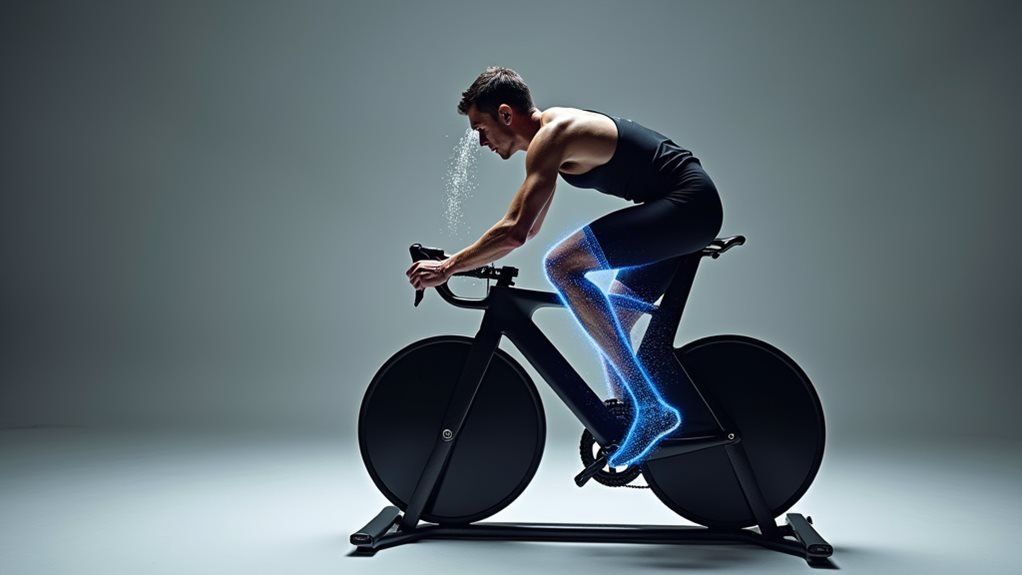
Three key principles define the science of low-impact training: controlled movement, reduced joint stress, and sustained cardiovascular benefits.
I'll tell you why this matters – your joints aren't designed for constant pounding. When you perform low-impact exercises, you're working with your body's natural biomechanics, not against them. This makes it especially beneficial for those with mobility issues.
Here's the fascinating part: you don't need high-impact moves to get high-intensity results. Your heart doesn't know whether you're running or cycling – it just responds to demand. Exercise bikes burn more calories in less time while providing a low-impact workout that minimizes stress on your joints. Through careful manipulation of resistance and tempo on a static bike, you'll achieve the same cardiovascular benefits without the joint wear and tear. This kind of exercise is excellent for weight management while being gentle on your body.
The science gets even better. Low-impact training allows for longer, more frequent workouts because your recovery time shrinks dramatically. You're not dealing with the microscopic damage that high-impact activities inflict. Instead, you're building strength through controlled resistance, improving flexibility through full range of motion, and boosting endurance without compromising joint integrity. Trust me – your future self will thank you for choosing the smarter path to fitness.
Protecting Your Knees While Cycling
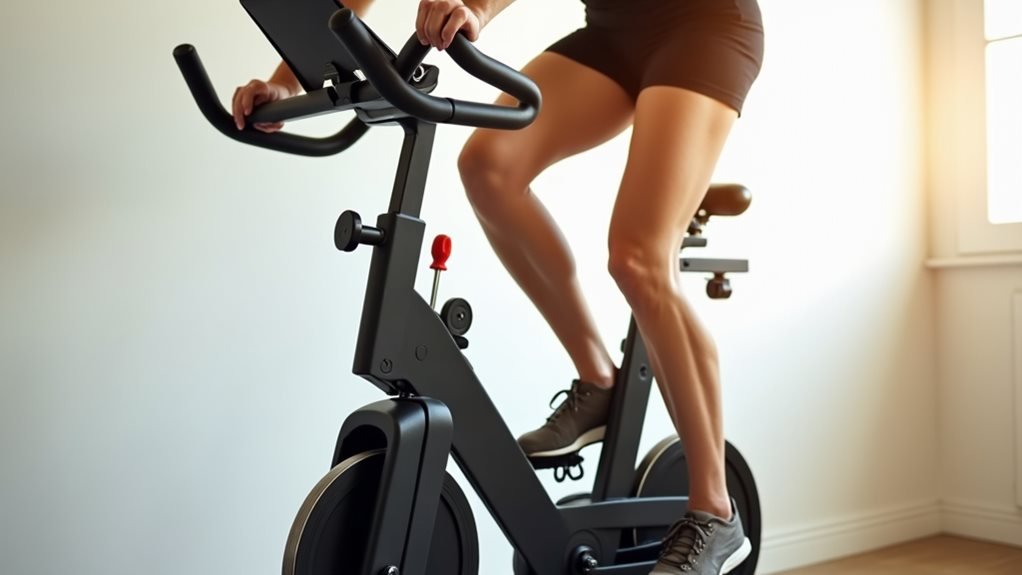
Protecting your knees while cycling starts with proper bike setup and technique – I can't stress this enough. Your knee should bend between 25-35 degrees at the bottom of each pedal stroke. Trust me, get this wrong, and you'll feel it where it hurts.
Here's the deal: too low a seat crushes your quads and leads to front knee pain. Too high? You'll feel it in the back of your knee. I'll make this simple – align your seat with your hip bone, then fine-tune from there. Low-impact cycling helps maintain healthy cartilage in your knees. Regular cycling on a stationary bike provides cardiovascular benefits while protecting your joints.
If you're dealing with back issues or balance concerns, I'd steer you toward a recumbent bike. They're not as flashy as spin bikes, but your spine will thank you.
Let's talk form because I see this mistake constantly. Don't just slam those quads – engage your glutes, especially at the furthest point of your pedal stroke. And please, stop pedaling backwards – it's not doing what you think it is.
Keep that knee bent to 115-120 degrees, and unless you've got ligament issues, ditch the knee brace. Your joints deserve better than compensating for poor form.
Building Strength Without Joint Stress
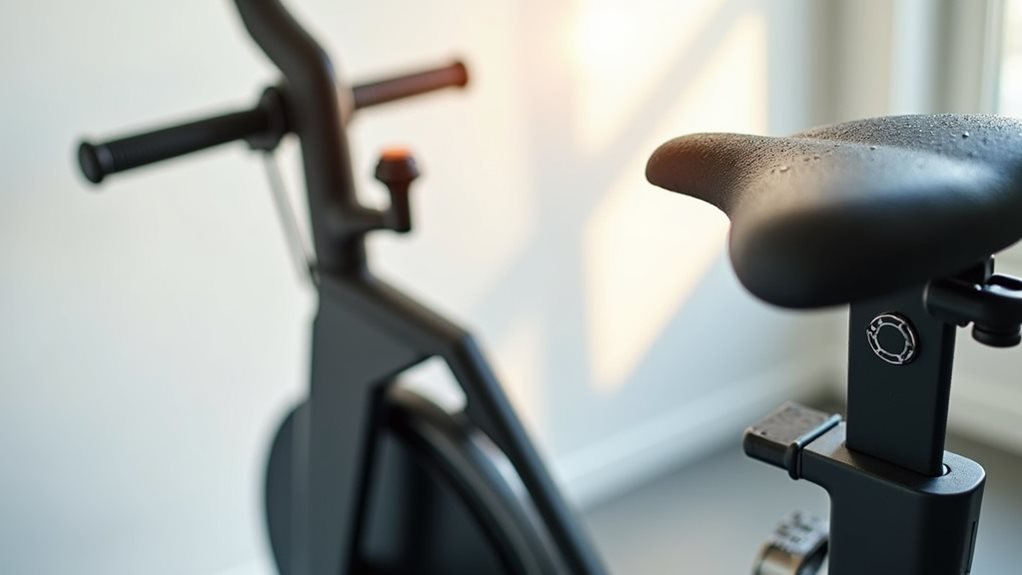
When it comes to building muscle, static bikes offer a golden opportunity to strengthen your body without punishing your joints. I'll tell you exactly why they're your secret weapon for sustainable strength gains.
Let's get straight to the sweet spot: static bikes target multiple muscle groups simultaneously. You're not just working those quads – you're engaging your hamstrings, calves, glutes, and core with every pedal stroke. And here's the kicker: you can dial up the resistance whenever you want, progressively challenging your muscles without risking joint damage. Synovial fluid production increases as you pedal, helping keep your joints well-lubricated. Regular sessions can burn 600 calories per hour while building endurance.
I'm particularly excited about dual-action bikes that incorporate moving handlebars. They're basically full-body workout machines in disguise. You'll build upper body strength while your legs are crushing it below. Trust me, it's efficient as hell.
The beauty of static cycling lies in its adaptability. Whether you're using an upright or recumbent model, you're strengthening the muscles that support your joints. This means better stability, improved balance, and reduced risk of injury. It's like building your body's natural armor, minus the battlefield trauma.
Weight Management Through Static Cycling
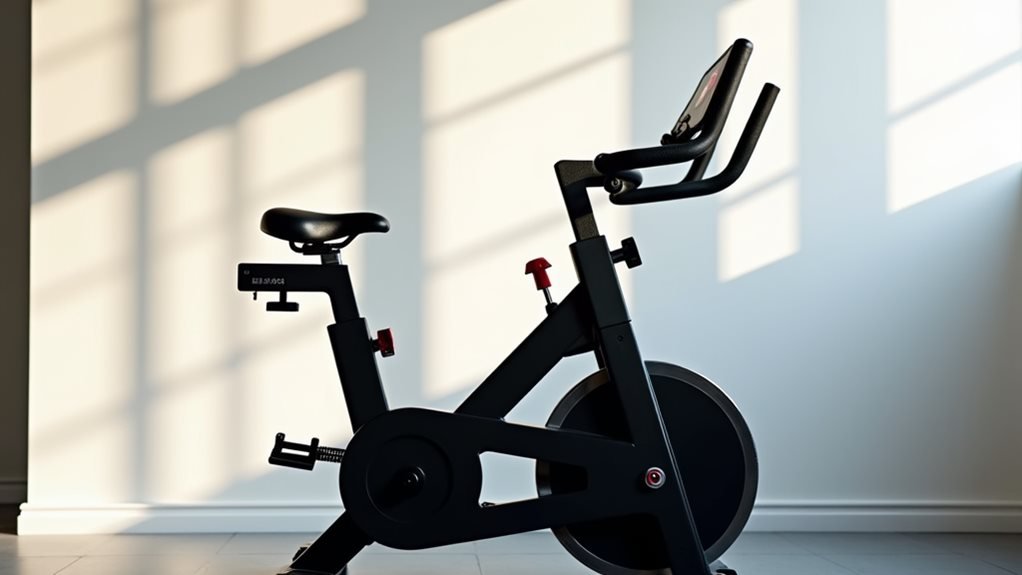
Through consistent static cycling, you'll discover one of the most effective paths to weight management. Let me break down the cold, hard numbers: a 45-minute session can torch up to 600 calories, and you'll need 3,500 calories burned to lose one pound of fat. The beginner-friendly nature of stationary bikes makes them perfect for starting your fitness journey. I'm telling you, that's achievable with smart, consistent training. Cycling is an excellent way to tone leg muscles while burning calories efficiently. Low-impact exercise benefits make stationary bikes particularly attractive for those seeking joint-friendly fitness options.
Want to maximize your fat-burning potential? Here's your battle plan:
- Push through three 60-minute LISS sessions weekly – that's 1,512 calories gone for a 155lb person
- Mix in HIIT intervals to spike your metabolism (trust me, your body will keep burning calories hours after)
- Maintain a 1,200-calorie daily diet alongside 45-minute sessions, three times weekly
- Track your progress through waist measurements and body fat percentage, not just scale weight
I've seen countless success stories, and here's the kicker – you're getting all these benefits without destroying your joints. Stick to this plan for a month, and you'll notice changes. Combine it with proper nutrition, and you're looking at significant fat loss while preserving your joint health. It's that simple.
Customizing Your Bike Workout
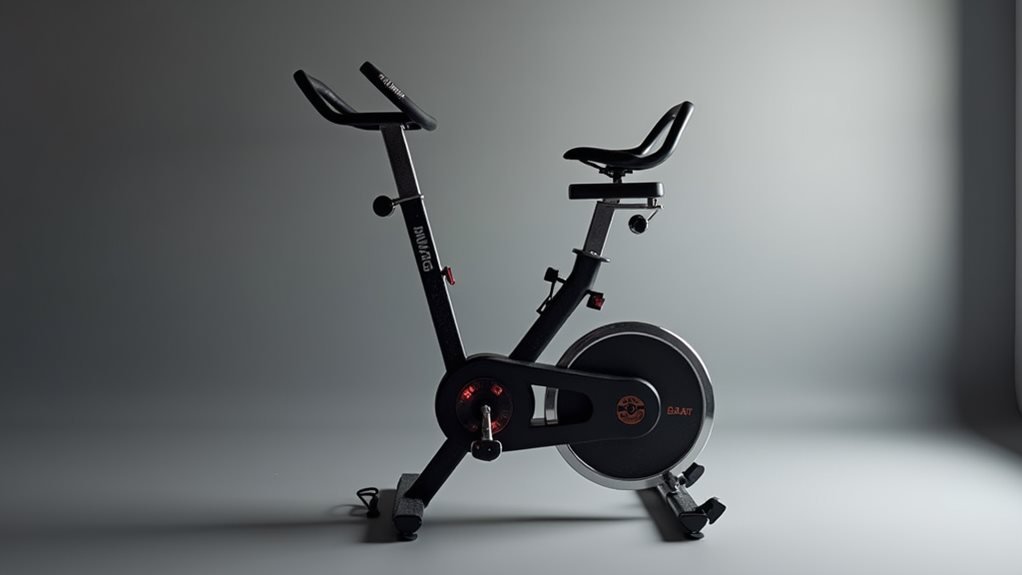
Start by connecting a Bluetooth heart rate monitor – it's your most reliable intensity gauge. I want you to use those heart rate zones to optimize every pedal stroke. Your threshold heart rate, determined through an FTP test, will define your training zones with scientific precision. Friction resistance dynamics from cycling physics underscore the importance of precision in your workout design.
Your bike's resistance levels aren't just random numbers. Whether you've got 24 levels on a NordicTrack or 32 on an Echelon, each increment serves a purpose. I'll have you switching between them strategically during interval training to spike your cardiovascular endurance.
Track your metrics religiously. Speed, time, distance – they're your progress markers. Want to get fancy? Import custom workouts from TrainingPeaks or let AI-driven platforms like TrainerRoad adjust your sessions based on performance data. Trust me, when you combine real-time feedback with structured training plans, you'll transform your static bike into a precision fitness instrument.
Making Exercise Accessible For Everyone
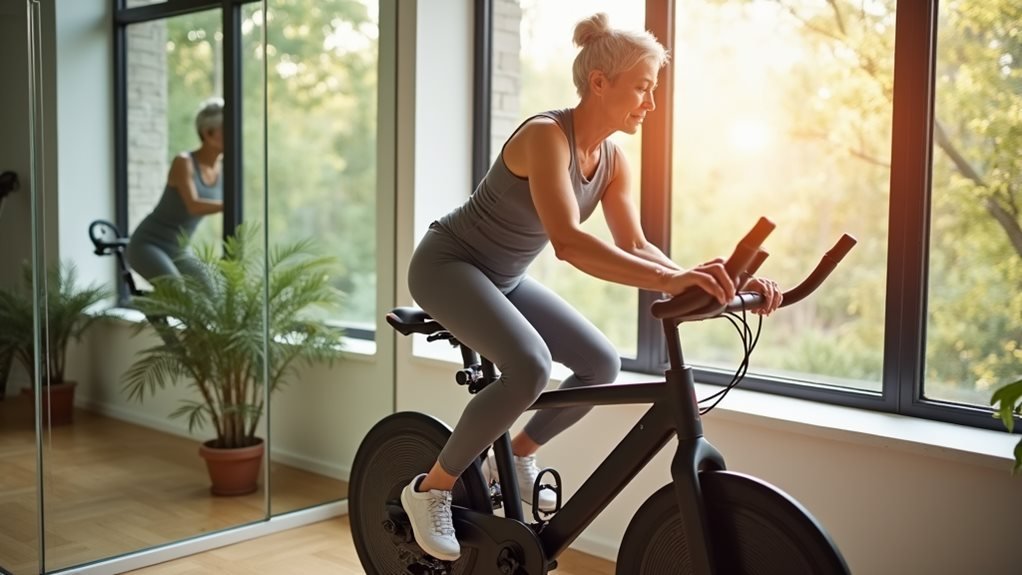
Three key features make static bikes one of the most accessible forms of exercise available today. I'm talking about their adaptability, convenience, and unmatched ability to accommodate various physical conditions. You won't find a more versatile piece of equipment for getting fit while protecting your joints.
Let me break down why static bikes are your ticket to inclusive fitness:
- They're perfect for balance-challenged individuals – no need to worry about falling when you're safely seated
- Weather's irrelevant – exercise any time, regardless of what's happening outside
- Resistance is completely customizable – start low, progress at your own pace
- Multiple bike styles available – from upright to recumbent, there's an option for everyone
Here's what makes me particularly excited about static bikes: they're ideal for both beginners and those managing chronic conditions. You can start with zero resistance and gradually build strength without risking injury. Whether you're recovering from surgery, managing arthritis, or just getting started with exercise, there's no better way to maintain fitness while protecting your joints. Trust me, your body will thank you.
Frequently Asked Questions
Can Static Cycling Help With Recovery After Total Knee Replacement Surgery?
I recommend static cycling for knee replacement recovery, as it's low-impact, strengthens muscles, improves range of motion, and you can start as early as two weeks post-surgery.
How Long Should Beginners Spend on a Static Bike Each Session?
Like dipping your toes in water, I recommend starting with 5-10 minutes per session. Once you're comfortable, I'd gradually increase to 20 minutes over several weeks of consistent practice.
Does Static Cycling Affect Bone Density Compared to Weight-Bearing Exercises?
I'll tell you straight: static cycling won't help your bone density like weight-bearing exercises do. Since you're not loading your bones against gravity, you'll need additional weight-bearing activities for best bone health.
Are There Specific Static Bike Models Designed for People With Arthritis?
I'd recommend recumbent bikes and high-handlebar models with adjustable resistance for arthritis. Look for NuStep, Schwinn 270, or Sole R92, which offer excellent joint support and comfort.
Should You Stretch Before or After Using a Static Bike?
Picture your muscles like rubber bands – they need care. I recommend stretching both before and after cycling to prevent injury and enhance recovery, giving you the best workout experience.
